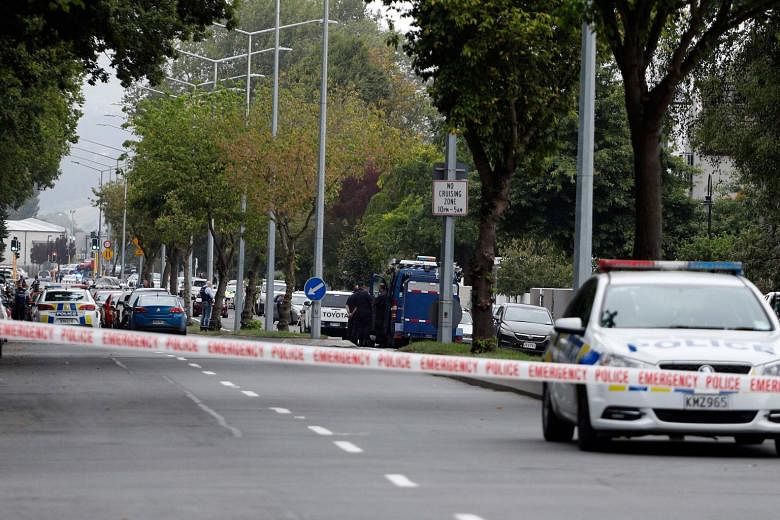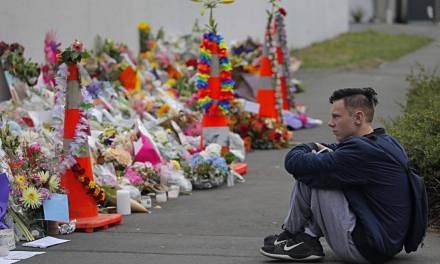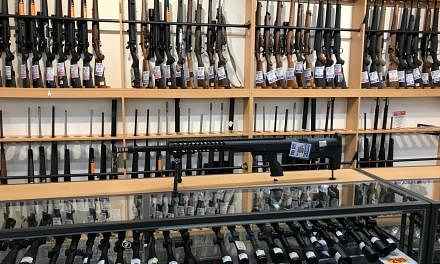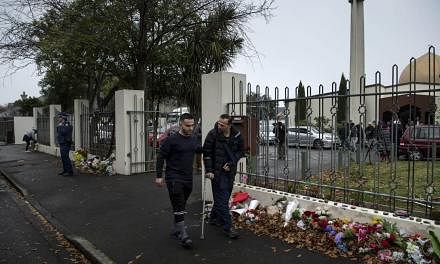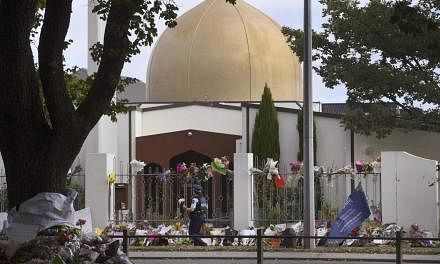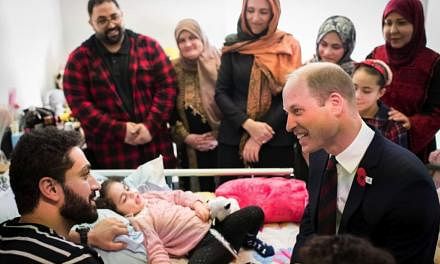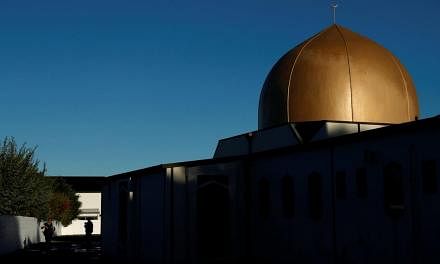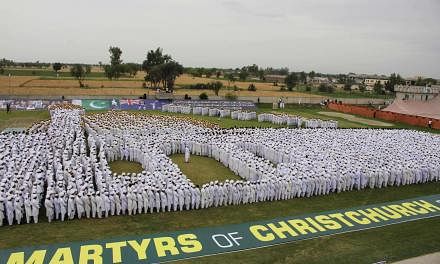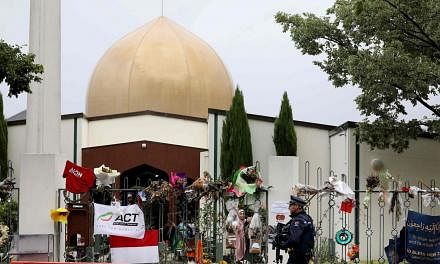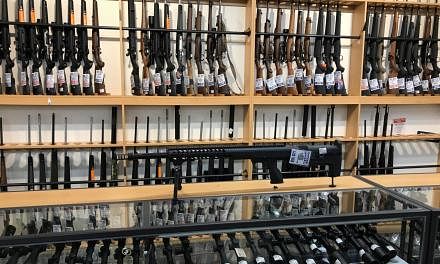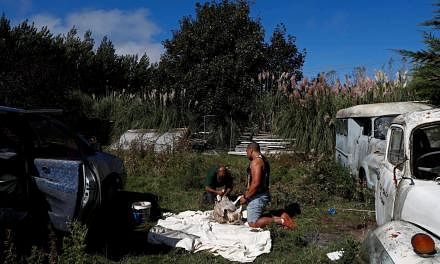CHRISTCHURCH (WASHINGTON POST) - The recording blinked to life shortly after 1.30pm on Friday (March 16) to reveal the ordinary grey interior of a Subaru Outback.
The overcast skies of the late New Zealand summer filtered through the windshield, casting pale light on three rifles laying across the passenger seat.
With the camera mounted on the driver's helmet, all that was visible of him were legs beneath the steering wheel, clad in tactical protective wear, and flashes of green, fingerless gloves as he fumbled with his gear.
An occasional glimpse of a fair, clean-shaven chin crossed the rear view mirror.
"All right," he said before putting the car in gear. "Let's get this party started."
It was short drive towards downtown Christchurch, a historic, English-flavoured city on New Zealand's South Island.
"Take the second left towards city centre," the windshield-mounted navigator intoned, and the man - later identified by police as a 28-year-old Australian named Brenton Harrison Tarrant - put on his turn signal.
He drove carefully. At one red light, he reached to turn on a strobe attached to the military-style rifle resting between his leg and the door.
A few blocks on, he hit a button and a Serbian nationalist song filled the car. He had made a mix tape for a long-planned massacre.
A day earlier, he had allegedly uploaded a 74-page manifesto online that obsessed over immigration and "white genocide".
Minutes before the attack, a link to the manifesto was posted on the website 8chan, along with a chilling promise to live-stream an "attack against the invaders".
Five minutes into the live Facebook video, the attacker pulled into a driveway on Deans Avenue, turned around in a small parking area and finally positioned the Subaru at the end of the drive, pointing outward, ready for a fast exit.
Methodically, he readied his guns and magazines, all of which had been covered with white lettering and symbols, including references to Adolf Hitler's Mein Kampf and the names of mass shooters.
Military fife-and-drum music was playing as he climbed out of the Subaru, lifted the car's rear hatch door and uncovered two other graffiti-covered rifles and multiple red gas cans.
Selecting an additional shotgun, he walked to the sidewalk, leaving the car hatch open and the car running.
The street was quiet; only one elderly couple seemed to notice as he carried his weapons a few yards to the grounds of Christchurch's Al Noor Mosque, its high minaret rising above an angular whitewashed building.

The attacker ignored the pair and entered a parking lot crowded with small cars. One man walking on the far side looked his way as he advanced steadily towards the arched front entrance flanked by tall evergreen shrubs.
Suddenly, the centre of the image was filled, as it would be for much of the next six minutes, with the pointing barrel of the rifle.
Several figures stood at the top of the steps, just inside the entrance. Someone could be heard saying, "Hello, brother."
The worshipper nearest was turning away from the camera, just a dozen feet away. The rifle tip moved over the centre of his back.
About 1.40pm, just before regular Friday prayers at Al Noor got underway, the gunman pulled the trigger for the first time.
Al Noor is Christchurch's most prominent mosque, serving a local Muslim population of about 3,000. Its golden dome is a landmark for cricket players and other visitors to the city's central park across the street.
New Zealand's 50,000 Muslims make up only 1 per cent of the population, but the country has welcomed increasing numbers of families fleeing hardship in recent years.
Gathering for prayers on Friday were immigrants and refugees from Syria, Jordan, Pakistan and Bangladesh.
The shooting, when it started, was relentless.
The first dull pop was followed by eight more in four seconds. The gunman, never pausing, stepped through the entrance-way, already lined with bodies lying among the shoes of dozens more worshippers within.
What followed was a calm, methodical onslaught, hundreds of rounds that would kill more than 40 and wound dozens more.

At first, some worshippers thought the sound of gunfire was simply one of the mosque's speakers crackling.
"Then we heard screaming," Mr Nour Tavis told the New Zealand Herald.
"Everyone panicked," he said. "There was shooting and shooting and shooting... People were running and all of a sudden you saw them fall."
Firing almost constantly, the shooter did not hesitate to train his weapon on any human he encountered - those fleeing, those cowering, the injured.
He canvassed the small suite of interior rooms, returning repeatedly to the central prayer room, where dozens huddled in two corners.
Mr Adeeb Sami, a 52-year-old engineer, had flown from Dubai to New Zealand the day before to surprise his twin children on their 23rd birthday, which was Friday, his daughter told Gulf News.
Amid the firing, Mr Sami reportedly threw his body over two of his sons, taking at least one bullet near his spine but shielding them. All three would survive.
Many others were not as lucky. The father of a Syrian family that had fled to New Zealand to escape the carnage in their country was killed. So was a 71-old refugee who had survived decades of war in his native Afghanistan.
Mr Tavis, a Moroccan who moved to New Zealand 15 years ago, told the New Zealand Herald he escaped by crawling through a broken a window.
Later, Mr Tavis said, he re-entered the mosque to try to help.
"There were people bleeding to death," he told the New Zealand Herald. "It was terrible."
When the gunman had no moving targets to shoot, he returned to those already down, shooting them until the green-patterned floor was a litter of shell casings and gore.
The gunman, unrushed, replaced clips more than once. Then he headed back outside, stopping to unload several shots down the sidewalk at fleeing pedestrians, first to the right and then to the left.
Back at his car, he grabbed a new weapon and one of the gas cans and returned to the front of the mosque.
At the top of the driveway, he fired repeatedly at someone not visible deep in the parking lot.
The gunman was breathing heavy now, muttering something hard to understand to his "lads".
He mounted the front steps, now running with blood, and went back inside for an additional 70 seconds, killing a few who had managed to avoid his first attack.
He exited the front for the last time just as two figures were scrambling through a gap in the wall.
He hit the second one, a woman who went down on the sidewalk immediately in front of his waiting car.
Her cries for help grew louder as he approached but were silenced when he shot again.
"I am the god of hellfire," was the lyric of his soundtrack as he slammed the hatch, climbed in the vehicle and drove off, turning left on Deans Avenue.
Within a short distance he stopped, programmed something into the navigator and then, suddenly, heaved a gun barrel up beside the dangling pine-tree air freshener and shot through the windshield at someone out of camera range.
For the next few minutes, he progressed haltingly on the roadway, firing once at a car pulling in front him.
He stopped to fire a shotgun round at someone else, shattering his passenger window.
Soon he was driving rapidly, talking, marvelling at how many people were in the mosque, how crowded the car park had been.
"It was too quick. I should have stayed longer," he said. "There was time for the fuel... Burn that f-ing mosque to the ground."
He seemed calm.
About nine minutes after the first shot, the sound of a police siren penetrated the music for the first time. The video ended, but the slaughter would continue.
The gunman was travelling in the direction of a second, smaller mosque 6km away.

The Linwood Mosque, a gray framed building no bigger than a ranch house, was busy with a Friday crowd of families, including many young children.
As police were responding to calls from Al Noor, shots erupted at Linwood.
Inside, several dozen terrified worshippers tried to take cover as the gunman burst into the prayer room.
"There were old people sitting on the chairs and praying," Mr Syed Mazharuddin told the New Zealand Herald. "He started shooting at them."
Seven would be killed at Linwood, bringing the day's death toll to 49.
Among them, according to grieving relatives around the world, were a four-year-old boy and a 12-year-old boy.
"He was shooting indiscriminately," Mr Mazharuddin said. "There was a lady screaming, 'Help! Help!', and he shot point blank in her face."
A young man who works at the mosque as a caretaker rushed the shooter, Mr Mazharuddin said.
"He saw an opportunity and pounced on him and took his gun," he said.
The gunman allegedly fled to his car and left the scene as the cries of pain and grief rose.
Shortly after, police said. they had him.
Following a chase, patrol cars forced a Subaru onto the curb of a divided Christchurch street.
Officers dragged the suspect from the front seat, apparently uninjured, after a spasm of violence that killed more people in one afternoon than New Zealand typically suffers in a year.
By the end of the day, as emergency rooms scrambled to treat the wounded and families gathered to mourn the dead, police had three people in custody, including Tarrant, a former fitness instructor who moved to New Zealand two years ago.
Authorities said Tarrant had a gun licence and used five weapons in the attacks. At an initial court hearing on Saturday, he did not enter a plea.
And a peaceful country had begun the long investigation into a brutally violent day.
